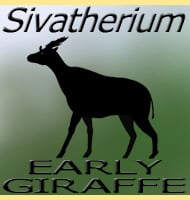In Depth
Although Dryopithecus is known to have had a broad geographic distribution, it is particularly well known from European countries such as France, Spain and Hungary. Dryopithecus is often associated with the orangutan-like Sivapithecus, however study of Dryopithecus fossils indicate that it was actually very different in life. The main difference between these two genera are the teeth with those Dryopithecus having proportionately thinner enamel, something that suggests that Dryopithecus ate mainly soft vegetation such as fruits. This has led to suggestion that Dryopithecus may have been more a dedicated frugivore, a specialist herbivore that eats mainly fruit rather than other plant parts such as leaves and stems.
Dryopithecus is thought to have spent much of its time living in the tree canopy where it moved about by swinging from branch to branch, a form of locomotion called brachiation. When walking however, Dryopithecus is thought to have walked in a quadrupedal posture similar to that of a chimpanzee, but instead of walking on its knuckles it is thought that it walked upon the flats of its hands due to morphological differences in the limbs and wrists between Dryopithecus and chimpanzees.
Another primate that is sometimes considered to be similar to Dryopithecus is Oreopithecus.
Further Reading
– Note sur un grand Singe fossile qui se rattache au groupe des Singes Sup�rieurs [Note on the large ape fossils related to the great apes]. – Comptes Rendus de l’Acad�mie des Sciences de Paris (in French). 43: 219–223. – �. Lartet – 1856. – Biological sciences: humerus of Dryopithecus from Saint Gaudens, France. – Nature. 229 (5, 284): 406–407. – D. Pilbeam & E. L. Simons – 1971. – Mandibular ontogeny in the Miocene great ape Dryopithecus. – International Journal of Primatology. 4 (4): 331–337. – E. L. Simons & W. Meinel – 1983. – Dryopithecus crusafonti sp. nov., a new Miocene Hominoid species from Can Ponsic (northeastern Spain). – American Journal of Physical Anthropology. 87 (3): 291–309. – D. R. begun – 1992. – A Dryopithecus skeleton and the origins of great-ape locomotion. – Nature. 379 (6, 561): 156–159. – S. Moy�-Sol� & M. K�hler – 1996. – A new cranium of Dryopithecus from Rudab�nya, Hungary. – Journal of Human Evolution. 41 (6): 689–700. – L. Kordos & D. R. Begun – 2001. – Eurasian hominoid evolution in the light of recent Dryopithecus findings, by M. K�hler, S. Moy�-Sol� & D. Alba. In, Hominoid evolution and climatic change in Europe. 2. Cambridge University Press – L. de Bonis, G. D Koufos & P. Andrews (eds). – Sivapithecus is east and Dryopithecus is west, and never the twain shall meet. – Anthropological Science. 113 (1): 53–64. – D. R. Begun – 2005. – Paleoenvironment of Dryopithecus brancoi at Rudab�nya, Hungary: evidence from dental meso- and micro-wear analyses of large vegetarian mammals. – Journal of Human Evolution. 53 (4): 331–349. – G. Merceron, E. Schulz, L. Kordos & T. M. Kaiser – 2007. – Dryopithecins, Darwin, de Bonis, and the European origin of the African apes and human clade. – Geodiversitas. 31 (4): 789–816. – D. R. Begun – 2009. – First partial face and upper dentition of the Middle Miocene hominoid Dryopithecus fontani from Abocador de Can Mata (Vall�s-Pened�s Basin, Catalonia, NE Spain): taxonomic and phylogenetic implications. – American Journal of Physical Anthropology. 139 (2): 126–145. – S. Moy�-Sol�, M. K�hler – D. M. Alba – 2009. – Earliest evidence of caries lesion in hominids reveal sugar-rich diet for a Middle Miocene dryopithecine from Europe. – PLOS ONE. 13 (8): e0203307. – J. Fuss, G. Uhlig & M. B�hme – 2018.









